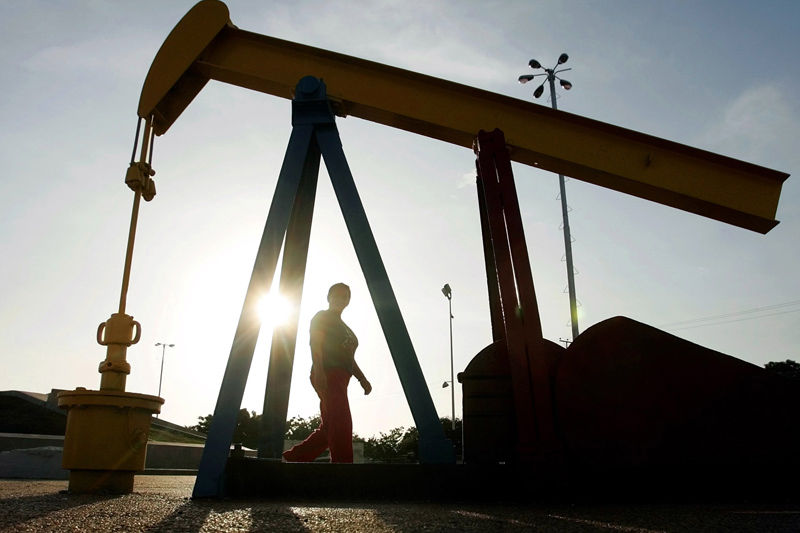Investing.com - Crude oil futures regained strength on Tuesday, rebounding from a three-day low as jitters over Greece’s debt crisis receded and as investors awaited the outcome of a key meeting of Federal Reserve policymakers later in the day.
On the New York Mercantile Exchange, light sweet crude futures for delivery in April traded at USD106.83 a barrel during European morning trade, gaining 0.46%.
It earlier rose by as much as 0.65% to trade at a daily high of USD107.13 a barrel. Prices fell to a three-day low of USD105.37 a barrel on Monday.
Market sentiment firmed after euro zone finance ministers indicated that Greece would receive formal approval for its second bailout early this week.
Head of the Eurogroup of finance ministers, Jean-Claude Juncker, said Monday there was "no doubt" that a second bailout for Greece, worth EUR130 billion, would be approved later in the week.
Meanwhile, the Eurogroup meeting continues Tuesday, with ministers likely to discuss Spain’s debt situation, demanding it aim for a tougher deficit target this year in order to get back on target in 2013.
Spain’s Prime Minister Mariano Rajoy announced earlier this month that the country would cut its public deficit to 5.8% of annual output, instead of the planned 4.4% this year.
Euro zone developments have dominated trading in the oil market for the last several months, with prices tracking investor sentiment toward the region’s debt crisis.
Meanwhile, traders were awaiting the outcome of a Federal Reserve policy meeting later in the day.
The meeting comes after Friday’s robust U.S. employment data, which showed that the U.S. economy added 227,000 jobs in February, beating expectations for a 210,000 gain.
The upbeat data diminished expectations for a fresh round of asset purchases by the Federal Reserve to help stimulate economic growth.
However, the Wall Street Journal reported last week that the Fed is considering a strategy that would allow it to undertake another round of bond buying, while lowering the risk of inflation.
Meanwhile, oil traders continued to monitor tensions between Iran and the West surrounding the Islamic Republic’s nuclear program.
The West is expected to reinforce its tough stance against Iran's nuclear program this week when U.S. President Barack Obama and British Prime Minister David Cameron meet.
The stand-off between Iran and Western countries surrounding the Islamic Republic’s nuclear program has dominated sentiment in the oil market for weeks.
Growing tensions between Iran and Israel also remain in focus. There are fears that an escalation of hostilities between Israel and Iran could set off a conflict across the region and send oil prices skyrocketing.
Iran produces about 3.5 million barrels of oil a day, making it the second largest oil producer in the OPEC, after Saudi Arabia.
Elsewhere, on the ICE Futures Exchange, Brent oil futures for April delivery was up 0.35% to trade at 125.20 a barrel, with the spread between the Brent and crude contracts standing at USD18.37.
On the New York Mercantile Exchange, light sweet crude futures for delivery in April traded at USD106.83 a barrel during European morning trade, gaining 0.46%.
It earlier rose by as much as 0.65% to trade at a daily high of USD107.13 a barrel. Prices fell to a three-day low of USD105.37 a barrel on Monday.
Market sentiment firmed after euro zone finance ministers indicated that Greece would receive formal approval for its second bailout early this week.
Head of the Eurogroup of finance ministers, Jean-Claude Juncker, said Monday there was "no doubt" that a second bailout for Greece, worth EUR130 billion, would be approved later in the week.
Meanwhile, the Eurogroup meeting continues Tuesday, with ministers likely to discuss Spain’s debt situation, demanding it aim for a tougher deficit target this year in order to get back on target in 2013.
Spain’s Prime Minister Mariano Rajoy announced earlier this month that the country would cut its public deficit to 5.8% of annual output, instead of the planned 4.4% this year.
Euro zone developments have dominated trading in the oil market for the last several months, with prices tracking investor sentiment toward the region’s debt crisis.
Meanwhile, traders were awaiting the outcome of a Federal Reserve policy meeting later in the day.
The meeting comes after Friday’s robust U.S. employment data, which showed that the U.S. economy added 227,000 jobs in February, beating expectations for a 210,000 gain.
The upbeat data diminished expectations for a fresh round of asset purchases by the Federal Reserve to help stimulate economic growth.
However, the Wall Street Journal reported last week that the Fed is considering a strategy that would allow it to undertake another round of bond buying, while lowering the risk of inflation.
Meanwhile, oil traders continued to monitor tensions between Iran and the West surrounding the Islamic Republic’s nuclear program.
The West is expected to reinforce its tough stance against Iran's nuclear program this week when U.S. President Barack Obama and British Prime Minister David Cameron meet.
The stand-off between Iran and Western countries surrounding the Islamic Republic’s nuclear program has dominated sentiment in the oil market for weeks.
Growing tensions between Iran and Israel also remain in focus. There are fears that an escalation of hostilities between Israel and Iran could set off a conflict across the region and send oil prices skyrocketing.
Iran produces about 3.5 million barrels of oil a day, making it the second largest oil producer in the OPEC, after Saudi Arabia.
Elsewhere, on the ICE Futures Exchange, Brent oil futures for April delivery was up 0.35% to trade at 125.20 a barrel, with the spread between the Brent and crude contracts standing at USD18.37.
